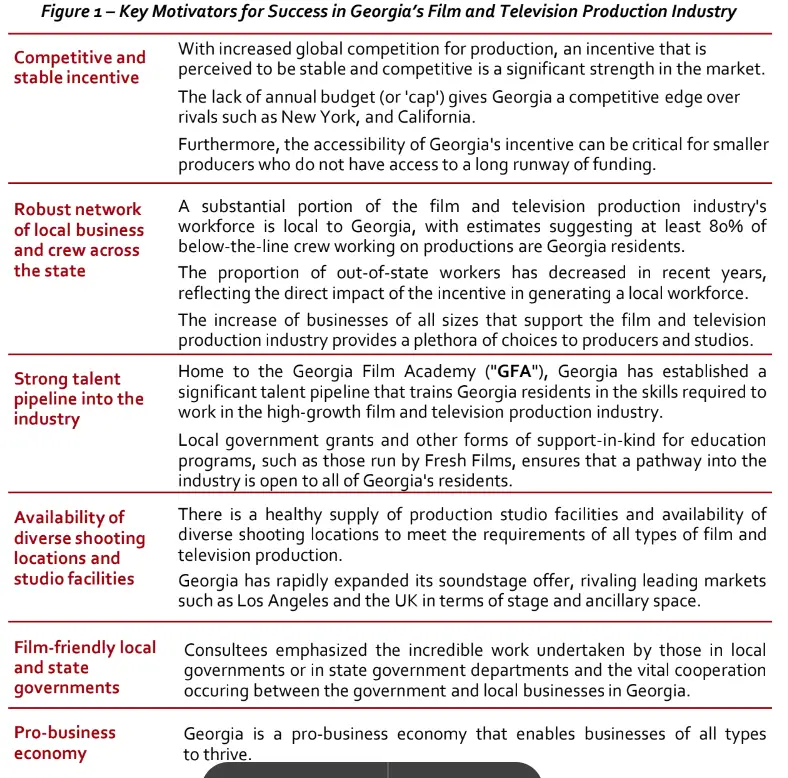- Producers Guild of America Green Best Practices Guide
- Sustainability of Screen Character Choices
- Climate Action Blueprint for Screen
- Film and TV Carbon Emissions Regional Analysis in North America
- Green Production Guide (How To)
- North America Regional Analysis Film and TV Carbon Emissions
- Carbon Emissions of Film and Television Production
- Lights! Camera! Clean Energy! Guide to Film Production
EXECUTIVE SUMMARY
Study Overview
In 2023, global screen sector consulting firm Olsberg•SPI (“SPI”) was commissioned by the Georgia Screen Entertainment Coalition (“GSEC”) to evaluate the impact of Georgia’s Entertainment Industry Tax Credit (the “Study”).
Georgia introduced the first version of the Entertainment Industry Tax Credit in 2005 to attract film and television projects to the state.1 Since its introduction, there have been multiple revisions to streamline and enhance the incentive. In its current form, the tax credit offers a 20% base incentive rate, with a 10% Georgia Entertainment Promotion (“GEP”) uplift for productions that include the Georgia promotion logo. Most recently, a mandatory audit requirement was introduced for all projects certified by the Georgia Department of Economic Development (“GDEcD”) on or after 1st January 2023 that must be completed ahead of final certification.2
Since introducing the tax credit, Georgia has gained prominence as one of the world’s leading film and television production hubs – attaining this status in an era of major competition from other jurisdictions. Stimulated by Georgia’s incentive, an increase in production expenditure has, in turn, led to major private investment in studio construction in the state. Studio investment – which is not directly incentivized by the state – has helped drive job creation and further strengthened Georgia’s status as a global production hub.
Key Findings
Global Growth of Film and Television Production and Incentives
In recent years, policy makers worldwide have increasingly recognized the significance of film and television production to foster economic and strategic development. The screen production industry has a proven ability to yield an attractive return on public investment, with effects on employment, infrastructure, and skills development. It is an industry with a varied supply chain and the ability to attract inward investment. Film and television can also stimulate tourism and drive international recognition of a place.
Following the COVID-19 pandemic, film and television production experienced strong growth – reaching $238 billion in global content expenditure in 2022. This upsurge in production is now facing some headwinds from global economic uncertainty, a rise in production costs, labor strikes in 2023, and structural industry shifts. These factors have prompted producers to place a greater emphasis on the value and stability offered by production incentives in offsetting significant financial risks. Despite the persistent challenges, the screen production industry continues to display resilience, especially in competitive and well-established markets such as Georgia.
Incentives for film and television production are increasingly being utilized as an effective policy lever to stimulate activity. There are now 113 such incentives available globally, including in 37 states of the US.
While the volume of incentive programs is increasing, there are only a handful of top-tier global production hubs able to service the most ambitious and impactful film and television productions on an ongoing basis. Georgia is one of the few leading production centers in the US and the world, alongside markets such as California, New York, Canada (specifically British Columbia and Ontario), the UK, and Australia.
Georgia’s Development as a Global Film and Television Production Hub
Georgia offers a strong incentive, a variety of locations, highly developed studio infrastructure, a skilled and deep workforce, and a relatively affordable cost of living. Together, these elements have been fundamental to the growth of the film and television production industry in the state. Consultees for the Study identified the following motivators as key to Georgia’s success:
- Competitive and stable production incentive
- Robust network of local businesses and crew across the state
- Strong talent pipeline into the screen production industry
- Availability of diverse shooting locations and studio facilities
- Film-friendly local and state governments
- Pro-business economy.

Georgia’s Significant Growth in Screen Production
Film and television production in Georgia has boomed since fiscal year (FY) 2012. The Georgia Entertainment Industry Tax Credit has played an instrumental role in driving this growth.
Production expenditure in Georgia has increased at an average annual rate of over 17% between FY 2012 and FY 2023. Production spending in the state doubled between FY 2012 and FY 2016 and then doubled again from FY 2016 to FY 2022.
While production in FY 202o was affected by the pandemic, the screen production industry rebounded quickly and delivered a record production expenditure of $4.39 billion in FY 2022. A recent announcement suggests that production in FY 2023 declined slightly to $4.1 billion.3 While this reflects the impact of economic headwinds outlined above – particularly the impact of 2023 labor strikes – it underlines the continuing strength of Georgia’s incentive.

Expenditure on television and episodic content has become more dominant in Georgia since FY 2018, reflecting a wider global shift to television series production. Nevertheless, Georgia hosted 31 significant feature films in FY 2022 with an average budget of nearly $50 million per production.
The explosion of production activity in Georgia outlined above has been accompanied by significant private sector investment in studio development. Between FY 2012 and FY 2022, $1.28 billion was spent on constructing new studio facilities, expanding existing facilities, and converting existing buildings.4 Investor confidence in Georgia is strong, and there is a $2.93 billion investment in studio construction planned for FY 2023 to FY 2027, none of which would happen without the tax credit for production (see section 1.2.7). 5

Expansion of Studio Infrastructure in Georgia
The growth of Georgia’s film and television production industry has also leveraged major expansion in studio infrastructure in the state. Georgia has approximately 5.7 million square feet of dedicated stage space across 212 stages. Of this total, 2.6 million square feet is dedicated stage space across 141 purpose-built stages.

If six further studio developments in Georgia proceed as planned, the total stage space in Georgia would increase to just over seven million square feet. These studio developments – four new developments and two expansions – would add a further 1.4 million square feet across 77 new stages in DeKalb, Clayton, Fayette, and Douglas Counties.
Overall Economic Impact of the Georgia Entertainment Industry Tax Credit
Georgia’s tax credit has led to a significantly increased level of incentivized film and television production in the state, which has, in turn, leveraged significant non-incentivized activity – such as the studio construction outlined in Figure 3. Together, Incentivized and non- incentivized activity generate significant economic impact for Georgia.6
This Study measures the impact of production expenditure attracted to Georgia because of the Georgia Entertainment Industry Tax Credit. The analysis utilizes IMPLAN, a widely used and respected economic modeling software. In addition, the impact of investment in studio construction which can be directly attributed to the tax credit is also analyzed. The total economic impact comprises the direct, indirect, and induced effects as outlined in Figure 4.

The production and studio construction effects of the tax credit can be combined to provide an overall assessment of the economic impact in terms of gross value added (“GVA” – i.e., the additional value created by an industry), economic output (i.e., the value of industry production), labor income7 , and jobs8 , which are summarized below.
Film and television production provides highly skilled, well-paid, desirable jobs that are less susceptible to automation and provide important benefits such as health insurance and retirement contributions. The average wage for those working in the motion picture and video industry9 in the US is $86,00010 – significantly higher than the Georgia state average of $58,000 across all industries. 11





Economic Return on Investment of the Georgia Entertainment Industry Tax Credit
Economic Return on Investment (“ROI”) measures how much economic value is created per $1 of investment in tax credits by the state, and it aligns with the economic development objectives of the tax credit. The ‘cost’ to the state is the estimated total value of the tax credits issued minus the additional state and local taxes received because of the uplift in production and studio construction activity.

Across the Study years (FY 2012 to FY 2022), the overall economic ROI of the tax credit is 6.3. This means that for every $1 invested through the program, the benefit to the state economy is $6.30 in terms of additional economic value from direct, indirect, and induced effects. The direct ROI is 3.7, so $3.70 of GVA is generated within the film and television production and construction industries due to the $1 investment, indirect ROI (supply chain value created) is $1, and a further $1.60 is due to induced effects.
The ‘cost’ of the incentive is foregone tax receipts by the state, and due to the transferability of the credit, it can be purchased and used to offset the tax liabilities of Georgia taxpayers outside of the screen production industry. The foregone tax receipts are incurred one or more years after the expenditure and related economic impact has occurred in Georgia. This gap reflects the time between production, audit, issuance ofthe tax credit, and its subsequent sale and utilization. This delay positively impacts the state’s financial position as the ‘cost’ is postponed. The current audit backlog and the increasing processing time contribute to the positive gap for the state.
Additionality of the Georgia Entertainment Industry Tax Credit
As part of the Study, SPI conducted two surveys with industry stakeholders to better understand the effects of the tax credit in attracting productions into Georgia and influencing studio construction investment decisions in the state. These surveys measure the additionality of the tax credit – i.e., whether the incentive stimulates production expenditure and studio construction investment that would not have otherwise occurred in Georgia. This is also called the ‘but for’ argument, with the additionality rate measuring the amount of impact that would not have occurred ‘but for’ the incentive.
Primary survey research of this kind is the only practical method to gather insights into the additionality of Georgia’s incentive. A quasi-experimental approach is impractical as it is impossible to identify ‘control’ jurisdictions or companies that are not influenced by incentive policy due to the globally interconnected nature of the screen production industry, the prevalence of incentives worldwide, and the industry’s high sensitivity to incentives. 13
The surveys found that production expenditure and studio construction investment would not have occurred at their current scale without the Georgia Entertainment Industry Tax Credit.
According to the surveyed producers, only 7.9% of production expenditure between FY 2018 and FY 2022 would have happened in the state without the incentive. The tax credit was identified as the most important factor in decision-making for producers when compared with factors such as cast, crew, infrastructure, and locations.
The survey of studio investors, operators, and owners found that for 94% of respondents, their investment would not have gone ahead in Georgia in the absence of the incentive. Weighting the responses based on the scale of the construction investment leads to a result of near-zero investment in the absence of the tax credit, meaning all studio investment can be attributed directly to the incentive. A similar pattern is found for planned investments. At least 73% of the surveyed respondents with plans to invest in Georgia stated that the Georgia Entertainment Industry Tax Credit was the only factor in their decision. The remaining 27% consider the tax credit of great importance.
Ripple Analysis of Georgia Productions
Film and television production in Georgia impacts various economic sectors outside the screen production industry. This is because the production of film and television is a manufacturing process that requires a wide variety of inputs, including workers – varying in creative, technical, logistical, and support roles – as well as equipment, facilities, infrastructure, and services. While a portion of a project’s expenditure is directed towards screen production- specific vendors, significant spending is also directed into other areas of the economy, such as real estate and hospitality services, that do not solely service the screen production industry.
To model this impact, SPI worked with two productions – a high-budget television series and a high-budget feature film – that had filmed in Georgia and accessed the state’s incentive.
In the case of the high-budget television series, 39.1% of total below-the-line spend was retained in the screen sector – i.e., to individuals and businesses who only work in screen production. This means that nearly 61% of the production’s spend flowed to a wide range of other sectors in Georgia, including location fees and real estate, construction, and general local labor.14
In the case of the high-budget feature film, demonstrated below in Figure 11, 33.2% of total below-the-line spend was retained in the screen production sector – i.e., to individuals and businesses who only work in screen production. This means that nearly 67% of the production’s spend flowed to a wide range of other sectors in Georgia.

Wider Strategic Impacts of the Georgia Entertainment Industry Tax Credit
Beyond the economic impact of film and television production, the screen production industry stimulates wider strategic impacts relating to workforce development, education and training, screen tourism, brand investment, and placemaking.
The local Georgia workforce employed on film and television productions in the state has increased significantly since the introduction of the Georgia Entertainment Industry Tax Credit. Estimates from the industry now suggest that at least 80% of crew working on most productions in the state are residents of Georgia. Membership of IATSE Local 479 – which represents below-the-line crew from departments like construction, grip, and electrical – has increased by more than 250% since 2013. The continuity of work provided by the tax credit has enabled more Georgia residents to work in this high-growth industry.
Film and television content is also a proven motivator for tourists to visit an area or location and can also have significant effects on marketing, brand building, and other strategic impacts for a location.
Since Georgia is a major global production hub, hosting highly popular projects such as The Walking Dead (2010-2022), Stranger Things (2016-present), and The Vampire Diaries (2009- 2017), domestic and international tourists are drawn to Georgia to visit production locations. This generates considerable additional visitor expenditure, benefitting local businesses and contributing to place branding. Covington and Senoia are two examples of this phenomenon.
SPI research indicates that, in 2022, Georgia welcomed approximately 852,000 additional visitors who were drawn to the state solely because of film and television series filmed in Georgia. These visitors spent a total of $172 million in the state.
Factors Affecting the Future Growth of Georgia’s Film and Television Production Industry
Consultees agreed that remaining competitive is the greatest challenge and threat to the Georgia film and television production industry. Georgia’s competitive position is underpinned by a strong incentive program that the screen production industry perceives to be stable. The reliability and stability of an incentive are critical for investors, given the significant financial risks involved in film and television production.
Georgia faces increased competition from mature and emerging markets that are introducing new incentives or augmenting existing incentive offers. Ontario and British Columbia in Canada are already offering producers an incentive worth at least 37% by enabling the federal and province incentives to be stacked. New York recently increased its annual budget and incentive rate from 25% to 30%. Several jurisdictions have measures to encourage productions to use local crew or shoot outside of metropolitan centers. Other states, such as New Jersey and New Mexico, have introduced incentives that offer exclusive benefits to studio developers. These incentives encourage infrastructure development and long-term investment commitments, which may close the gap between these programs and Georgia’s.
In addition to maintaining its position as a major global hub, Georgia also has several areas for potential development, including:
- Increasing local content creation
- Exploring opportunities for investment outside Metro Atlanta.
There is an opportunity for more content to be created from inception within the state. Georgia has established itself as a pivotal film and television production industry able to service productions of all sizes – including blockbusters like Black Panther (2018), Avengers: Endgame (2019), and Stranger Things (2016-present). However, consultees believe there is room for more local content to be created in the state. Consultees referred to the success of Tyler Perry, who has been producing content in Georgia since the 1990s. By 2019, feature films directed by Tyler Perry had grossed more than $1 billion worldwide and created numerous employment opportunities for Georgia businesses and individuals.15 Faith-based filmmaking was also identified as a growth area of content creation, with production company Kendrick Brothers being one of Georgia’s foremost producers of faith-based content.
As Georgia’s screen production industry expands, there is also an opportunity to encourage investment outside of Metro Atlanta. The majority of Georgia’s existing stage space is situated in or around Metro Atlanta, reflecting the area’s growth as a primary production hub. Crew, vendors, and ancillary businesses develop around studios, with clustering effects. However, as the screen production industry in Georgia has grown, new hubs have developed.16 Savannah is a convincing example of this potential. While Savannah already had a rich history as a production location, the introduction of the Savannah Regional Film Commission and Savannah Entertainment Production Incentive in 2015 encouraged further development and growth in the region. By 2022, there was nearly $207 million in direct spending in Savannah by 101 productions.




















